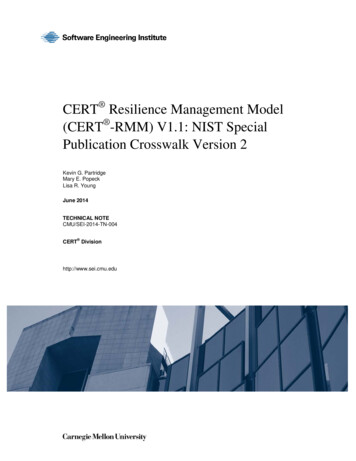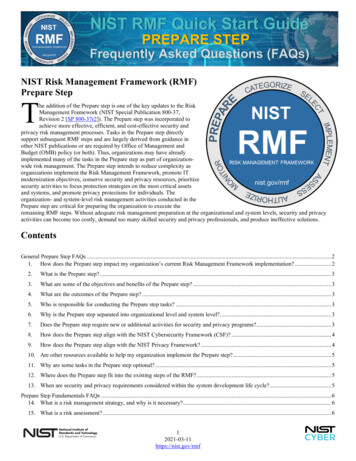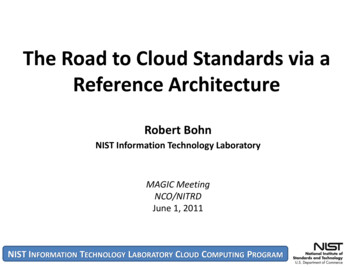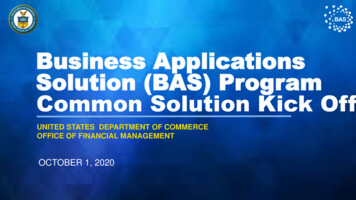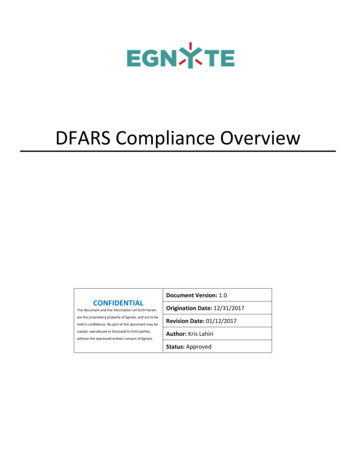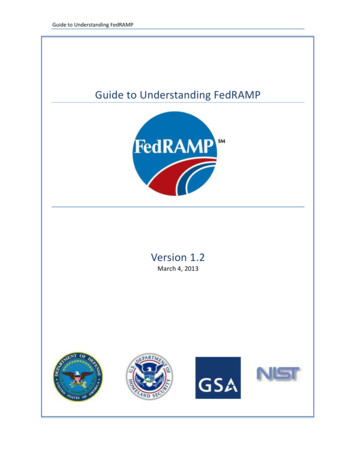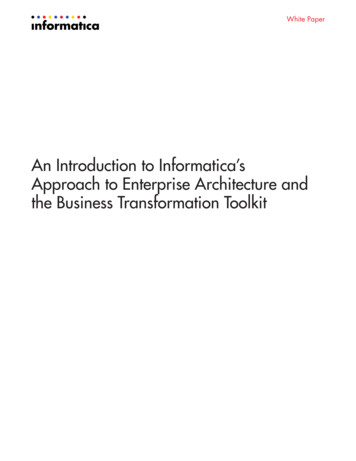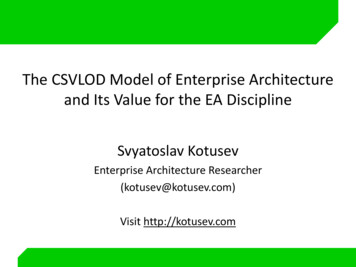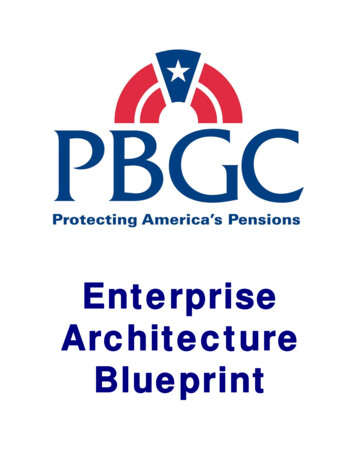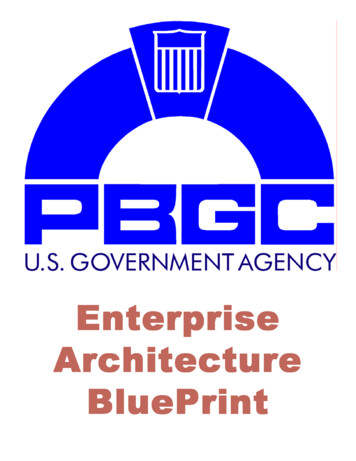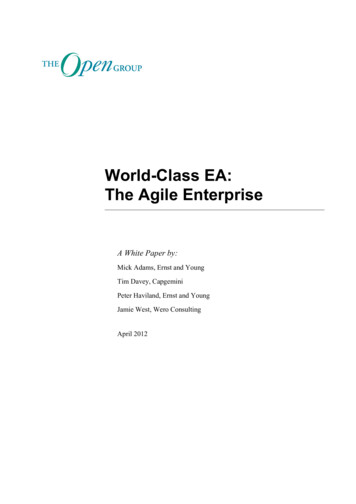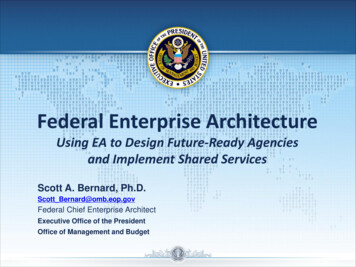
Transcription
Federal Enterprise ArchitectureUsing EA to Design Future-Ready Agenciesand Implement Shared ServicesScott A. Bernard, Ph.D.Scott Bernard@omb.eop.govFederal Chief Enterprise ArchitectExecutive Office of the PresidentOffice of Management and Budget
OMB Policy Directives on EAIT Shared ServicesStrategy(May 2012)Common Approach toFederal EA(May 2012)SVR MemoShared ServicesIs Action Item #6May 2, 2012May 2, 2012M-11-29CIO Authorities Memo:Commodity IT (Aug 2011)Consumer Agency #7Consumer Agency #6RequirementsConsumerAgency #5RequirementsConsumerAgency #4RequirementsConsumerAgency #3Security and PrivacySecurity and Privacy ControlsSecurity and Privacy ControlsSecurity and Privacy ControlsSecurity and Privacy ControlsSecurity and Privacy ControlsSecurity and Privacy ControlsSecurity and Privacy ControlsIT Reform Agenda’s25-Point Plan(Dec 2010)RequirementsConsumerAgency #2WorkflowConsumerAgency #1 flowRequirementsWorkflowData ExchangeRequirementsWorkflowData ExchangeWorkflowData ExchangeWorkflowData ExchangeApplicationsWorkflowData ExchangeApplicationsData ExchangeApplicationsData ExchangeApplicationsHostingData stingSharedService2
The Role of Enterprise ArchitectureThe Common Approach toFederal Enterprise Architectureis OMB policy on EA standards.IRMStrategicPlanConsumer Agency #7Consumer Agency #6RequirementsConsumerAgency #5RequirementsConsumerAgency #4RequirementsConsumerAgency #3Security and PrivacySecurity and Privacy ControlsSecurity and Privacy ControlsSecurity and Privacy ControlsSecurity and Privacy ControlsSecurity and Privacy ControlsSecurity and Privacy ControlsSecurity and Privacy ControlsFEAv2 is the implementationof the Common Approach, itprovides design and analysismethods to support sharedservice implementation, DGS,IRM Strategic Plans, andPortfolioStat investment reviews.RequirementsConsumerAgency #2WorkflowConsumerAgency #1 WorkflowRequirementsProviderAgency WorkflowRequirementsRequirementsWorkflowData ExchangeRequirementsWorkflowData ExchangeWorkflowData ExchangeWorkflowData ExchangeApplicationsWorkflowData ExchangeApplicationsData ExchangeApplicationsData ExchangeApplicationsHostingData stingSharedService3
The Common Approach to Federal EACommon ApproachFEADoDAFOtherThe Common Approach to Federal Enterprise Architecturehelps to make agencies “Future-Ready” by acceleratingagency business transformation and new technologyenablement by providing standardization, design principles,scalability, an enterprise roadmap, and a repeatablearchitecture project method.3
Common Approach Meta-ModelLevels ofScopeProgramElementsPrimaryOutcomesFramework5
Primary Outcomes Service DeliveryFunctional IntegrationResource OptimizationAuthoritative ReferenceWhile there are many positive outcomes that EAcontributes to, these four outcomes are “primary” inthat they represent areas of direct, positive impactthat architectures can make within and betweenagencies and with customers and partners externalto government6
EA Project Levels of Scope temApplicationThese levels of scope promote consistency in architecturemethods to promote comparability and support varying levels ofcomplexity. Solution Architecture is done in a similar way at alllevels of scope, using the Collaborative Planning Method (CPM)7
EA Program Basic ToolsStandardsUseReportingAuditThese basic elements ensure that agency EA programs arecomplete and can be effective in developing solutions thatsupport planning and decision-making.8
Element 1: Governance9
Element 2: PrinciplesGeneral EA PrinciplesDesign/Analysis Principles Strategic Drivers Business Activities Technology EnablementFuture-ReadyInvestment SupportShared ServicesInteroperability StandardsInformation AccessSecurity and PrivacyTechnology Adoption10
Element 3: Method for EA ProjectsThe Collaborative Planning Methodology (CPM) is arepeatable process that consists of steps that requireintegrated multi-disciplinary activities to affect change withthe collaboration of leaders, stakeholders, planners, andimplementers.It is inclusive of the full planning and implementation lifecycleand is intended for use at all levels of scope.11
Element 3: Method (continued)1.1Engage Sponsor andAssess StakeholderNeeds2.1Iden fy Organiza onsand Service Providers toEngage3.1Formalize Collabora vePlanning Team andLaunch Planning4.1Define Funding Strategyand Make Decision5.1Operate with the NewCapabili es1.2Analyze and ValidateNeeds2.2Analyze Opportuni esto Leverage3.2Refine the Vision forPerformance andOutcomes4.2Obtain Resources andValidate Plan5.2Measure PerformanceAgainst Metrics1.3Formulate Case toAddress the Needs2.3Determine Whether toLeverage3.3Analyze the CurrentState, DetermineAdjustments, and Planthe Target State4.3Execute the Plan5.3Analyze and ProvideFeedback1.4Iden fy and EngageGovernance3.4Formulate theIntegrated Plan andRoadmap3.5Ini ate Execu onGovernance12
Element 4: EA Tools Repository website and content to create a visual representation ofarchitecture in its current and future states Decomposable views of the overall architecture and specific architectures Over-arching “management views” of the architecture Strategic planning products and performance measures Business process documentation to answer questions and solve problems Physical / logical design of data entities, objects, applications, and systems Physical and logical design of networks & cloud computing environments Configuration management and quality standards Security and risk solutions for physical, information, personnel andoperational needs13
Element 5: StandardsEA standards fordoing design projectsEA standards fordoing analysis projectsArtifact’s ListStrategic PlanWorkflow DiagramDataflow DiagramSystem InterfaceNetwork DiagramSecurity ControlsDesignAnalysis14
Element 6: UseThe Common Approach supports: Shared-Services ImplementationCloud-First ImplementationDigital Strategy – Mobile & WebTechStats / PortfolioStatsSecurity and Privacy Control DesignBusiness Process ImprovementBig DataData Center ConsolidationVoice, Data, Video Convergence15
Element 7: Reporting Annual submission to OMB that “tells the story” of the agency’suse of IT to enable mission, support, and commodity functions. Due April 1st – these are public documents, nothing sensitive in it. Format Guidelines: Main Body: a) Synopsis of IRM Strategic Plan and goalsb) Enterprise-wide business and technology architecturec) Transition Plan milestones Appendix 1: IT Asset Inventory Appendix 2: IT Commodity Consolidation Plan (M-11-29) Appendix 3: Agency Shared Services Plan (improve quality & uptake) Appendix 4: EA Program Assessment / Project Value Measurement16
Element 8: Audit Roadmap (Appendix 4)provides an evaluation of:– EA Program maturity– The value of EA projects Uses EA Management MaturityFramework v2 (EAMMF), Aug 201017
The Federal Enterprise ArchitectureVersion 2.0 (FEAv2)Implementing the Common Approach18
Common Approach & FEAv2Common ApproachFEAv2DoDAFOtherThe Common Approach to Federal Enterprise Architecture(Common Approach) accelerates supports the identification ofopportunities for shared services and design alternatives. TheFederal EA version 2 (FEAv2) will be released in January 2013and aligns with the standards of the Common Approach.19
FEAv2: Major ComponentsFEAv2 aligns with the Common Approachand has three major components:Common Approach Standards:– Framework– ArtifactsFEADoDAFOther Methods:– Common Approach– Collaborative Planning Method (former FSAM) Analytics / Reporting:– Consolidated Reference Model– Ex 53 & 300– Enterprise Roadmap20
FEAv2 Standards: Framework & Artifacts The standard artifact list consistsof the “core” artifacts that needto be considered and/or tailoredto support a robust set of EAartifacts for the organizationEA3 CubeLevel/ThreadStrategicGoals &Initiatives(I)BusinessProducts &Services(B)ArtifactID T-2W-1W-2W-3Artifact Name(* Composite Artifact)Strategic Plan*SWOT AnalysisConcept of Operations ScenarioConcept of Operations DiagramBalanced Scorecard *Business Plan*Node Connectivity DiagramSwim Lane Process Diagram *Business Process/Service ModelBusiness Process/ Product Matrix *Use Case Narrative & DiagramInvestment Business Case*Knowledge Management PlanInformation Exchange Matrix*Object State-Transition DiagramObject Event Sequence DiagramLogical Data ModelPhysical Data ModelActivity/Entity (CRUD) Matrix *Data Dictionary / Object LibrarySystem Interface DiagramSystem Communication DescriptionSystem Interface Matrix *System Data Flow DiagramSystem/Operations Matrix *Systems Data Exchange Matrix *System Performance Matrix *System Evolution DiagramWeb Application DiagramNetwork Connectivity DiagramNetwork InventoryCapital Equipment InventoryBuilding Blueprints *Network Center DiagramCable Plant DiagramRack Elevation DiagramSecurity and Privacy Plan*Security Solutions DescriptionSystem Accreditation Document*Continuity Of Operations Plan*Disaster Recovery Procedures *Technical Standards ProfileTechnology ForecastWorkforce Plan*Organization ChartKnowledge and Skills R1C6/R4, C6/R5C2/R2, C5R1C3/R1C4/R2C2/R2C4/R2C6/R3, C6/R4AV-1OV-1OV-2OV-5OV-5Core Artifact ListOV-6a, SV-10aStrategic Plan/Priority GoalsData &Information(D)Systems &Applications(SA)C1/R1, C1/R2C3/R2, C4/R2C1/R3C2/R2, C5/R3C1/R3C1/R4C1/R3, C4/R2C1/R5C3/R4, C3R2C2/R4, C3/R4C3/R4C4/R1C4/R2C4/R3Workflow DiagramDataflow DiagramSystem InterfacesNetworks rce(W)OV-3OV-6b, SV-10bOV-6c, SV-10cOV-7, rk DiagramSecurity ControlsTV-1TV-2, SV-9OV-4OV-421
FEAv2: Collaborative Planning MethodThe Collaborative Planning Methodology is a repeatable processthat consists of steps that require integrated multi-disciplinaryactivities to affect change with the collaboration of leaders,stakeholders, planners, and implementers.It is inclusive of the full planning and implementation lifecycleand is intended for use at all levels of scope.22
Method (continued)1.1Engage Sponsor andAssess StakeholderNeeds2.1Iden fy Organiza onsand Service Providers toEngage3.1Formalize Collabora vePlanning Team andLaunch Planning4.1Define Funding Strategyand Make Decision5.1Operate with the NewCapabili es1.2Analyze and ValidateNeeds2.2Analyze Opportuni esto Leverage3.2Refine the Vision forPerformance andOutcomes4.2Obtain Resources andValidate Plan5.2Measure PerformanceAgainst Metrics1.3Formulate Case toAddress the Needs2.3Determine Whether toLeverage3.3Analyze the CurrentState, DetermineAdjustments, and Planthe Target State4.3Execute the Plan5.3Analyze and ProvideFeedback1.4Iden fy and EngageGovernance3.4Formulate theIntegrated Plan andRoadmap3.5Ini ate Execu onGovernance23
FEAv2: Consolidated Reference Model2003-05 FEA RMsThe CRM consists of a set of interrelated “reference models” designed tofacilitate cross-agency analysis and the identification of duplicativeinvestments, gaps and opportunities for collaboration within and acrossagencies. Through the use of the CRM and vocabulary, IT portfolios can bebetter managed and leveraged across the federal government.24
FEAv2: The CRM’s Reference ModelsPRM – BRM – DRM – ARM – IRM – SRMThe Reference Models from have evolved from five in FEAv1 to sixin FEAv2. Each Reference Model consists of the following areas: Taxonomy – Provides for categorization and inventories. Methods – Incorporates associated best practices. Use Cases – Describes how the reference model will be applied andused in the federal government. This area will apply the referencemodels to the Collaborative Planning Method (CPM). Each referencemodel will have at least three use cases. Touch Points – The relationship between all of the reference models.25
Using EA to SupportShared Services Implementation26
IT Shared Service Concept OverviewInter-Agency Lines of Business / Business CentersLevelsChannelsInternal & External Host Networks / SystemsStandards“Common Approach” to USG ArchitectureOnline Service CatalogFederal HealthArchitecturePerformanceMgmt.Financial Mgmt.HR Mgmt.Records Mgmt.Public, Private, Hybrid CloudsGeospatialMissionAdministrativeEmail , Help Desk,& CollaborationInfrastructure& Asset Mgmt.Services(Examples)CommodityWebsites &Content Mgmt.CategoriesIntra-Agency Shared Service CentersUncle Sam’s ListBusiness Models / Strategic Sourcing27
Architectural Components of a ServiceComponent1. RequirementsConsumer Agency #7Security and PrivacySecurity and Privacy ControlsSecurity and Privacy ControlsSecurity and Privacy ControlsSecurity and Privacy ControlsSecurity and Privacy ControlsSecurity and Privacy ControlsSecurity and Privacy ControlsConsumer Agency #6RequirementsConsumerAgency #5RequirementsConsumerAgency #4RequirementsConsumerAgency #32. WorkflowRequirementsConsumerAgency #2WorkflowConsumerAgency #1 flowRequirementsWorkflowData ExchangeRequirementsWorkflowData Exchange3. Data ExchangeWorkflowData ExchangeWorkflowData ExchangeApplicationsWorkflowData ExchangeApplicationsData ExchangeApplicationsData ExchangeApplicationsHostingData ExchangeApplicationsHosting4. ApplicationsHostingHosting5. HostingHostingHostingSharedService6. Security andPrivacyDescriptionThis includes the strategic and tactical requirements for thetype(s) of functionality that the service has to provide toconsumers. The type of requirements depends on the typeof service area, number and diversity of participatingagencies, sensitivity of information/data being exchanged.Business processes that function through the shared service.The design of a process must support the functionalrequirements from #1.The part of the business process in #2 that involves thecreation, exchange, manipulation, storage, or deletion ofdata and information.This includes the software and hardware that provide thefunctionality and data exchange capabilities that areidentified in #2 and #3.This is the infrastructure that the application(s) are hosted in.This includes cloud-based, client-server hosting solutions.The logical, physical, process, and personnel controls thatachieve required levels of protection and risk mitigation forthe service.28
Implementation: Two Work StreamsInter-Agency Shared ServicesIntra-Agency Shared ServicesAgency CIOsOwnerManaging PartnersCommodity ITScopeLOBs / Business CentersImplementation of Agency EnterpriseArchitecture/Shared Service Plans2012 FocusService ImprovementMigrations, EA PlansKeyDeliverableAssessment, Benchmarks, RoadmapIntra-AgencyService CenterCommodity IT(Dept. CIOs)Inter-AgencyLOBs / BCs(Managing Partners) Budget Financial Websites/CMS Email/Collaboration Mobile/Wireless GIS HR Performance Security8
Implementation and Initial Focus IT infrastructure Enterprise IT systems Business systems“Run”“Walk”Initial Focus“Crawl” Maximize the purchasing power of agencycontracts for commodity IT acquisitions (e.g.,PC contracts, email systems, etc.)7
IT Shared Service RolesManagingPartnerSupplierCustomers Managing Partner. The Federal agency that establishes and maintains theshared service with approval by agency leadership for intra-agency services,or by OMB for inter-agency services. Customer. The Federal agency or bureau that contracts with and pays themanaging partner to receive a shared service. Supplier. A government or commercial organization that actually providesthe shared service to consumers. Managing partners contract withsuppliers using Federal-wide contract vehicles whenever practicable.R-3
Architectural Components of a ServiceComponentDescription1. RequirementsThis includes the strategic and tactical requirements for the type(s) offunctionality that the service has to provide to consumers. The type ofrequirements depends on the type of service area, number and diversityof participating agencies, sensitivity of information/data being exchanged.2. WorkflowBusiness processes that function through the shared service. The designof a process must support the functional requirements from #1.3. Data ExchangeThe part of the business process in #2 that involves the creation,exchange, manipulation, storage, or deletion of data and information.4. ApplicationsThis includes the software and hardware that provide the functionalityand data exchange capabilities that are identified in #2 and #3.5. HostingThis is the infrastructure that the application(s) are hosted in. Thisincludes cloud-based, client-server hosting solutions.6. Security and PrivacyThe logical, physical, process, and personnel controls that achieverequired levels of protection and risk mitigation for the service.R-11
Using Enterprise Architecture toStandardize and Improve InformationSharing Environments33
Information Sharing 491355613587Top SecretSecretConfidentialNSSISMulti-Level StandardsEOsSensitive But Unclassified / PIINSD-42Unclassified34
QuestionsScott BernardScott Bernard@omb.eop.govFederal Chief Enterprise ArchitectOffice of Management and BudgetOffice of E-Government and IT
Federal Enterprise Architecture is OMB policy on EA standards. FEAv2 is the implementation of the Common Approach, it provides design and analysis methods to support shared service implementation, DGS, IRM Strategic Plans, and PortfolioStat investment reviews. IRM Strategic Plan The Role of
